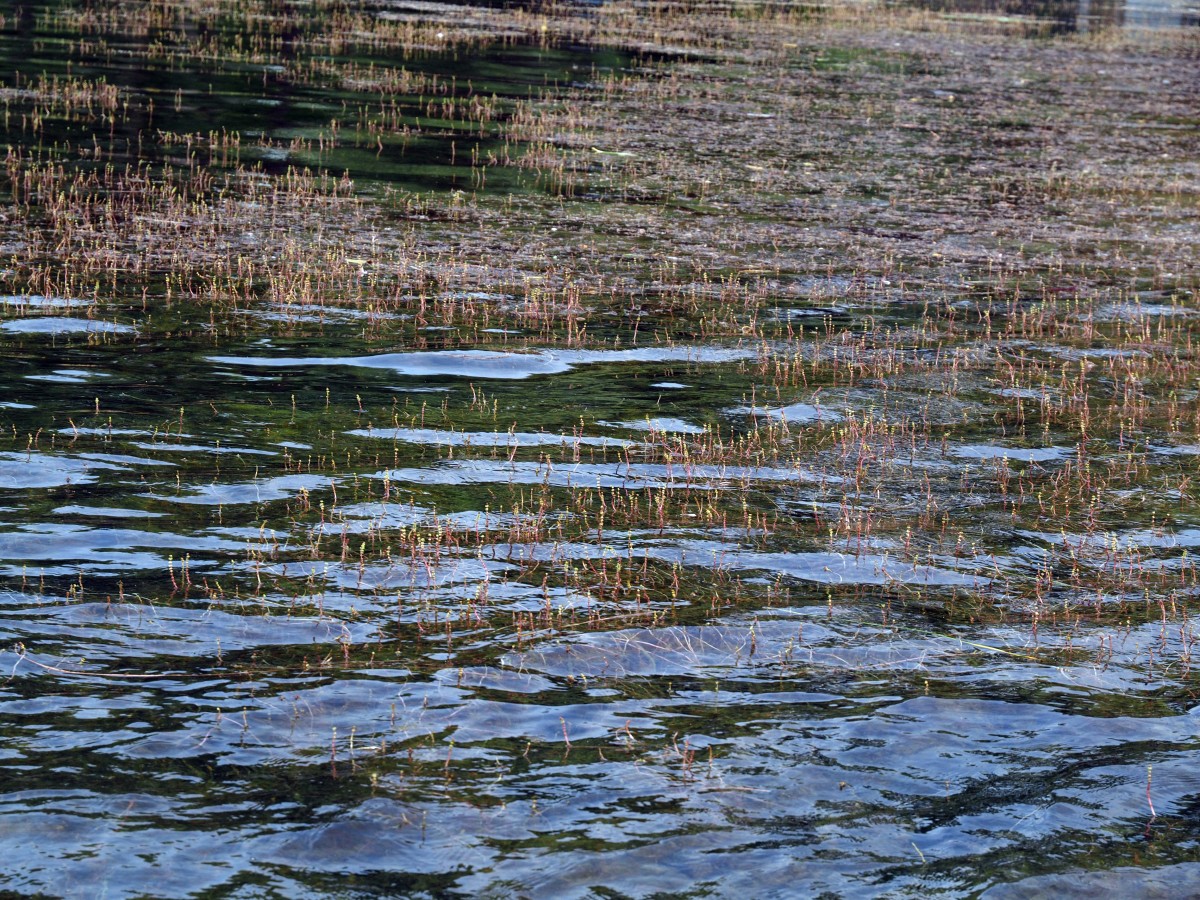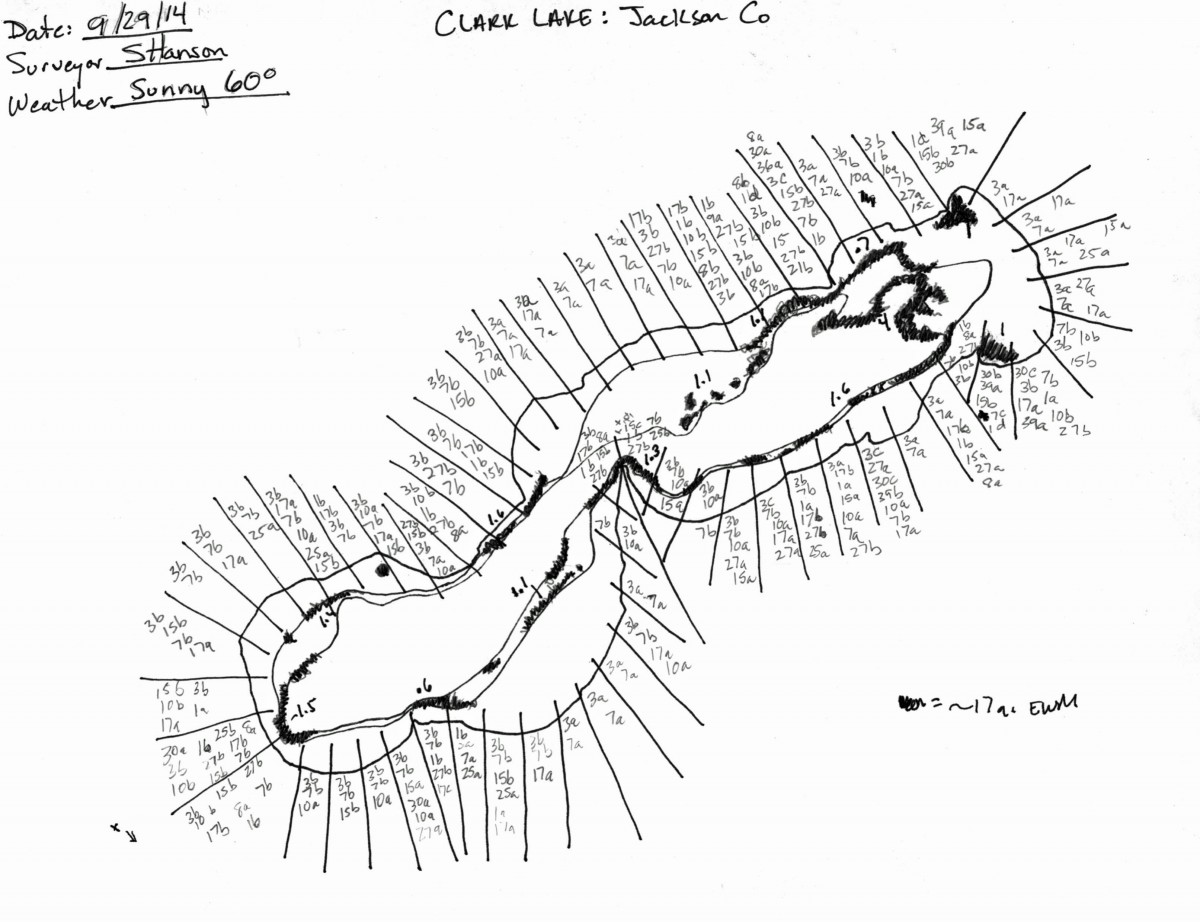As previously reported, the Clark Lake Invasive Species Committee is addressing the hybrid Eurasian Water Milfoil (HEWM) threat that now covers 20-arces of the lake. It propagates wildly and spreads quickly. In other lakes it has severely curtailed boating, swimming and fishing; destroyed natural habitat for wildlife; and negatively impacted property values. Its presence has been confirmed by DNA testing, and has been surveyed through a Clark Lake Spirit Foundation funded study of the infestation.
The Committee’s recent public information meeting on December 10, 2014, at Columbia Central High School, gave residents a chance to meet, hear about the problem and options for control, ask questions and get answers. The asking of questions came in two formats—through cards written, collected and given to the panel to answer; and later in the meeting, an open forum.
In the interest of space and clarity, what follows are paraphrased versions of both questions and answers. The purpose is to preserve the intent of the question and to provide credible, useful responses from those who have researched both the problem and solutions.
Since invasive weeds come into the lake by boats that have been elsewhere, shouldn’t there be hoses at boat launches and a requirement to wash boats before they go into the lake?
This is an idea worth exploring. But there are both infrastructure and enforcement challenges. Runoff from the boat washing must be collected, and there are strict rules in transporting it. It’s important to note that HEWM is already in the lake and no amount of boat washing will tamp its ever growing presence in Clark Lake. HEWM also arrives through visiting wildlife. Geese that have been at another lake in the morning visit Clark Lake in the afternoon. The “results” of their HEWM breakfast are then deposited in Clark Lake. That’s enough to start new colonies of HEWM.
Is there any way to control public boat access to the lake, and shouldn’t people who do use the lake be required to help pay for weed control?
This is a question for Columbia Township, Jackson County and the DEQ. It’s beyond the scope of the Committee.
Once HEWM is treated, what happens to the resulting biomass? Won’t this create more muck?
By not treating HEWM, there will be much more of it; and therefore, more muck. Early treatment will minimize the amount of biomass that sinks to the bottom.
Zebra mussels came and went. Won’t the same thing happen to HEWM?
The decline of zebra mussels was caused by a reduction of nutrients in the water that correlates with the installation of sewers. The growing number of zebra mussels also reduced the nutrient level forcing a self-correction of their numbers. HEWM is completely different. From the study of lakes that are infested, there is no evidence that it departs on its own; it only gets worse. HEWM creates a level of density that curtails boating, destroys wildlife habitat and reduces property values. One report said that ducks walked on top of infestations; another eyewitness watched muskrats, not swimming through it, but also walking on top of it. Try running a boat through the infestation around the County Park at the east end. It’s a no-go.
Do fertilizers used by some residents cause the weeds to propagate?
Fertilizer encourages the growth of all aquatic plant life, should it wash into the lake. But eliminating fertilizer will not stop the spread of HEWM.
What water depths does HEWM grow in?
HEWM will grow in 20 feet of water right up to the shoreline.
Isn’t 2,4-D in Agent Orange?
2,4-D was only one component of Agent Orange. The carcinogenic dioxin in Agent Orange is TCDD, a contaminant found in another component of Agent Orange, 2, 4, 5-T. Neither the American Cancer Society nor the U.S. Toxicology Program has listed 2,4-D as carcinogen. 2,4-D is regularly approved for aquatic use by the DEQ and is not banned by the EPA.
In Viet Nam, the defoliant Agent Orange, containing the TCDD dioxin, was applied in magnitudes of 10 to 100 times normal usage. Most people have some 2,4-D in their garage in the form of weed and feed or dandelion spray. If you got a small amount of that on you while spraying dandelions, you’d have a far greater dosage than from swimming in a lake right after treatment has taken place.
2,4-D has been in regular, safe, use since the 1940s. 2,4-D will not be used in areas within 250 feet of shorelines and its use is not planned for the pilot program in 2015.
Clark Lake is spring fed. Will 2,4-D contaminate my well?
No. Testing has shown no trace of 2,4-D in water from wells in treatment areas. The State is also reviewing rules with the purpose of scaling back the 24-hour swimming restriction and the 250-foot distance requirement from wells.
How long do chemicals last in the water?
Renovate, the chemical used within 250 feet of shorelines, leaves no trace after 24 hours; 2,4-D, slightly longer. If you have costly ornamental plants in your yard, it’s recommended that you wait 24 hours before using lake water on it if treatment has been performed in front of your house.
What’s the effect on wildlife? For example, if coots eat treated HEWM, and an eagle lunches on a coot, will the eagle be adversely affected?
No. There has been no evidence of detrimental effects on wildlife.
A questioner stated that Roundup has been banned in some areas. Why would we want to use Roundup in Clark Lake?
Roundup will not be used in Clark Lake.

When props have not lopped off the tops, you can see HEWM making it to the surface. This photo was taken near the County Park at the east end.
Can herbicides be applied early in the spring before the lake is being used for recreation?
Early spring is the ideal time for application. HEWM is first to grow in the spring and begins to spread before native plants begin their growth cycle. This allows for easier targeting.
What’s the worst downside of using herbicides in the lake?
It’s possible that treatment will not find every plant. Given that one tiny stem or leaf can generate millions of new plants suggests that ongoing treatment is necessary. After initial full lake treatment, experience shows that the degree of infestation declines markedly. For that reason, subsequent treatments can also be greatly reduced.
It’s been said that one plant leaf can propagate 250-million new plants in one season. Isn’t this an exaggeration?
That number came from SePro’s corporate website. Anecdotal evidence suggests that this number is not far off. A Clark Lake resident who also lives on a Texas lake says that there the weed started small, but then exploded in growth and quickly made boating impossible.
Couldn’t sand and gravel be dumped on the ice in the winter so that when the lake thaws the weeds are smothered?
This solution presents a number of challenges. Here are some of them. There are 20-acres of HEWM in the lake, ice moves when it breaks up (the sand and gravel could land somewhere other than the target), and DEQ permission would be refused. Also, it is possible the HEWM would still survive.
Milfoil has been around a long time. Why not treat it privately and not involve the government?
The invasion of HEWM is recent. The native milfoil combines with the Eurasian invader to form a hybrid. This hybrid multiplies rapidly with the deleterious effects already mentioned. When control methods are used, proper government permits are required.
Would a resident who decided to treat on his own be held liable if something goes wrong?
Treatment requires proper permitting. Though this is not an attorney’s answer–legal exposure could be an issue for rogue activity.
This was not a question, but a comment from a member of the audience who rose to say: I don’t like the idea of using chemicals in the lake, but I like even less the idea of losing the lake that we know. Observers noted that heads nodded while it was being said and was followed by applause.
Do you have a question? Send it to clarklakespirit@gmail.com.
Panelists: Vic Marshall, Dr. Richard Moyer, Bill Leutz, Dr. Carley Kratz (RRWC), Steve Hanson (PLM), Scott Robbins (Director of the Jackson County Parks), Bill Tuttle. The Committee: John Deming, Richard Moyer, Bill Leutz, Vic Marshall, Bill Tuttle, Mike McKay, John Calhoun, Flip Reynolds, Ron June, Beth June, Hugh Harris, Scott Robbins, Steve Harris, Greg Kerr, Rick Belcher.
Advisers: Dr. Carley Kratz (River Raisin Watershed Council), Kevin Thomson (attorney).












